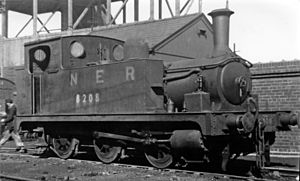This article includes a list of references, related reading, or external links, but its sources remain unclear because it lacks inline citations .(February 2015) |
| GCR Class 5A LNER Class J63 | |||||||||||||||||||||||||||||||||||||
|---|---|---|---|---|---|---|---|---|---|---|---|---|---|---|---|---|---|---|---|---|---|---|---|---|---|---|---|---|---|---|---|---|---|---|---|---|---|
 No. 8208 at Immingham engine shed in 1947 | |||||||||||||||||||||||||||||||||||||
| |||||||||||||||||||||||||||||||||||||
| |||||||||||||||||||||||||||||||||||||
| |||||||||||||||||||||||||||||||||||||
| |||||||||||||||||||||||||||||||||||||
The GCR Class 5A was a class of seven 0-6-0 T steams designed by John G. Robinson for work in docks operated by the Great Central Railway. [1] They passed to the London and North Eastern Railway at the grouping in 1923 and received the LNER classification J63.